I Volunteered for This Mission. I Could Take Photographs That Might Outlive Me.
I rode the third chopper in a daisy chain of five, each bird maybe 30 seconds behind the next. Clutching my M16 rifle in the left-side door gunner’s seat and surrounded by men cocooned in combat gear, I sat on a flak jacket in the vague hope that a slug coming up through the ship’s soft aluminum belly wouldn’t make me a eunuch.
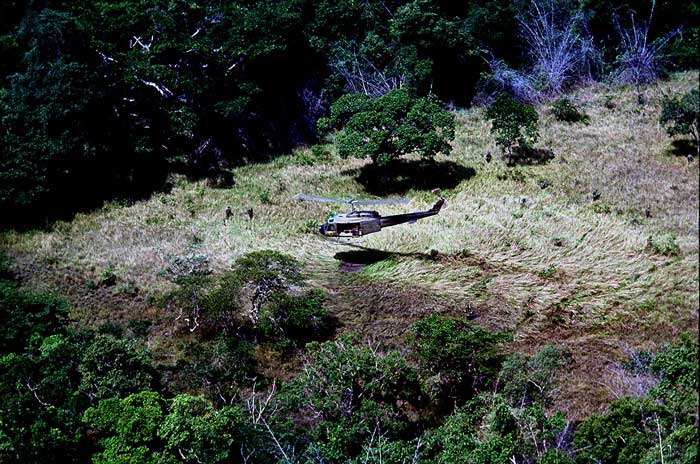
A UH-1B “Huey” lands with a squad of infantry. Photo by Marvin J. Wolf.
The regular door gunner was back at base camp; I had his seat because a Huey has only so much room—aside from the pilots and crew chief, who doubled as right-side door gunner, there were nine grunts aboard. My assignment was to photograph combat operations with A Company, 1st Battalion, 8th Cavalry. I’d been in Vietnam for almost six weeks. This was my first helicopter assault.
We flew nap-of-the-earth—as close to the ground as possible—in a swirling netherworld of cloud and mist. Rain condensed inside the helicopter. Everything dripped, all was wet—my rifle, uniform, exposed skin, my camera.
The camera was a Speed Graphic—a combat photographer’s joke, designed in 1912, with “improvements” and “features” grafted on for the next 30 years. Its outstanding feature was that it made me learn a new trick almost every time I used it. Nothing was automated. To make a single photo, I had to set the aperture and shutter speed, based on my guess about exposure—I had no light meter—then cock the shutter, remove the black steel “dark slide” protecting the film from accidental exposure, focus, compose a shot, then trip the shutter.
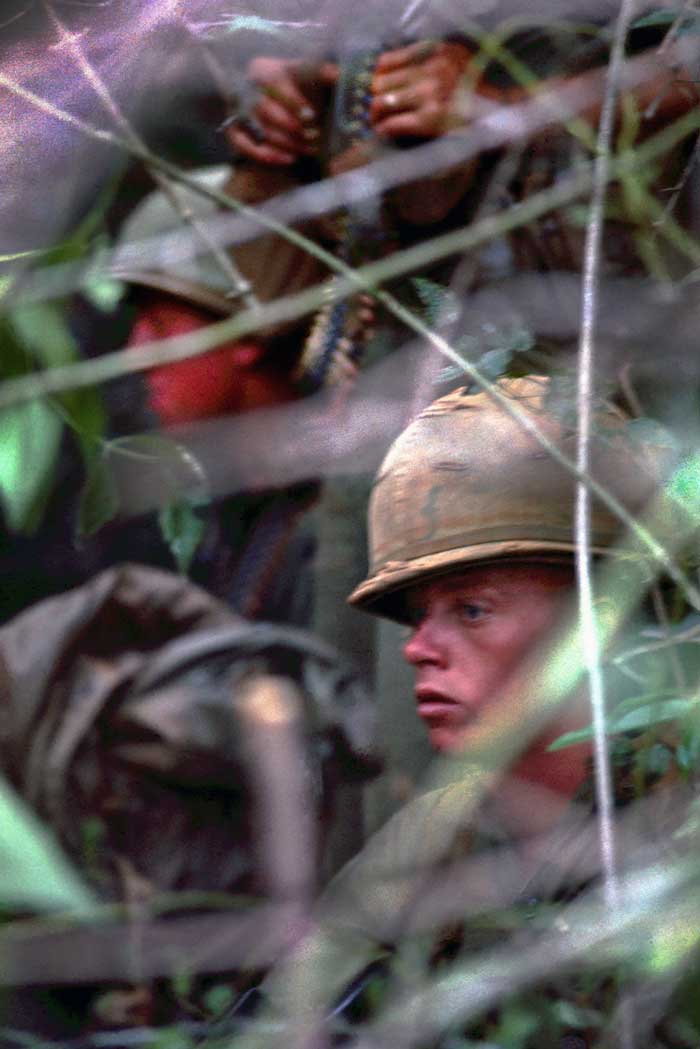
An ambush patrol waits for nightfall concealed by thick foliage. Photo by Marvin J. Wolf
If I didn’t pay close attention, I could double expose, shoot blanks, fog previous exposures, or make out-of-focus images. My particular camera was built in 1945, about the same age as most of the C rations we ate. It was a fabric-covered wooden box with fold-out bellows, two different shutters, and a Rube Goldberg film pack sticking out of the back. It was supposedly easier to use than earlier models’ old-fashioned film holders. I hated that box—but it and its twin were the only Army-issue cameras in the Air Cav Public Information Office.
Two minutes ahead, the lead chopper dipped into a jungle clearing called a landing zone, or LZ. I set the camera’s aperture and film speed, and “zone” focused it so anything 10 feet and farther would be acceptably sharp. If I didn’t bump it against something getting out of the helicopter.
And if I’d guessed right about the exposure.
In my headphones, I heard a pilot say something quick and terse that I couldn’t quite make out. In seconds the lead chopper lifted out, empty, whirling up through the green treetops and vanishing into the mist. Behind it, the second chopper dipped into the jungle and left my sight.
As we closed on the LZ, our bird slowed, bleeding airspeed, losing altitude. The second Huey climbed back up through the trees. Suddenly it erupted into a giant fireball! Our pilot cursed and pulled pitch and we shot skyward, grazing the very top of the flames. My nose and throat filled with the stench of burned hair. I gagged. My eyebrows vanished. My damp clothes were suddenly dry.
Then we were jinking left and right and hugging the hillside as we cleared the area. Two or three minutes ticked by—a lifetime. We banked sharply and circled back toward the LZ, the two Hueys behind us following in formation. The pilots yelled back and forth in my ears, discussing the situation. The gist of it was that there were at least two squads of grunts and possibly survivors from the second ship’s crew in the LZ. The pilots were deciding how best to get into that clearing with their remaining infantrymen.
And me.

Defender of mountaintop radio site during NVA attack. Flames are from napalm dropped very close by U.S. Air Force aircraft. Photo by Marvin J. Wolf.
My gut growled that even if I had to fly through fire twice—landing and taking off—staying on the chopper was less risky than joining those grunts in a jungle swarming with enemy troops. I might be there a long time. Or forever. I didn’t see what difference it would make to the guys on the ground, to the war, to my country, if I was with them in the jungle or if I stayed with the chopper.
In truth, I really didn’t want to get off that bird.
A voice in my ears, louder than before, said something about a Viet Cong .51-caliber machine gun higher up the hill and sighted along the LZ’s approach axis. Then another voice, fainter but different. Miles away, above the clouds, a pair of helicopter gunships were inbound, red-lined at 120 knots. Their tanks were nearly dry but might have fuel enough to put a few rockets on that 51.
Award-Winning Journalism in Your Inbox
Our pilots conversed again in my headset, making a plan. There wasn’t room in the LZ to land sideways, so we’d drop down below the ridge. While the gunships engaged the 51, we’d pop up on the LZ’s flank and try to side-slip in through the treetops. Black smoke marked the Huey’s hillside funeral pyre as we hurtled at 100 mph toward it.

A badly wounded infantryman is attended by a medic and comforted by his battalion commander. Photo by Marvin J. Wolf.
Unbidden, scenes from a life barely lived flashed by. Mistakes I had made. People I had disappointed. Friends I had wronged. A $20 bill I had filched from a drunken buddy’s wallet years earlier. A girl who gently spurned me. Another who laughed at my earnest efforts to interest her. My first sex. The last time. My demented mother. My struggling father. My baby brother, an unexpected, change-of-life child raised by siblings. My brooding, introverted brother, Ted. My brilliant brother, Matt. My older sister, Freyda, the Jesus-freak baby factory. My beautiful little sister, Ila, so desperate to escape our family madhouse that she married the first guy who asked and then had to run from him, too. Things I wanted to do, things I might now never get the chance to do. I had yet to feel truly loved. I might never be a father. No one would even miss me.
I cursed myself for a fool. I really didn’t have to be here.
Floundering, drowning in fear and self-loathing, I reminded myself why I was here. Why I was in Vietnam. On this helicopter. Why I had volunteered for this mission. And that if I did survive—maybe, even if I didn’t—then there was the possibility, at least, that I could get a picture, or maybe a few, and that people all over the world might eventually see them. Maybe forever. Maybe that wasn’t important to anybody else, but it was the reason I had reenlisted. And it was also the job the Army had given me to do.
I knew in my bones that if I didn’t un-ass this ’copter, this time, if I didn’t go boldly into that hot LZ with these grunts, if I didn’t believe in myself and my training and my buddies—then I never would. This time or never.
Was I a man or still pretending?
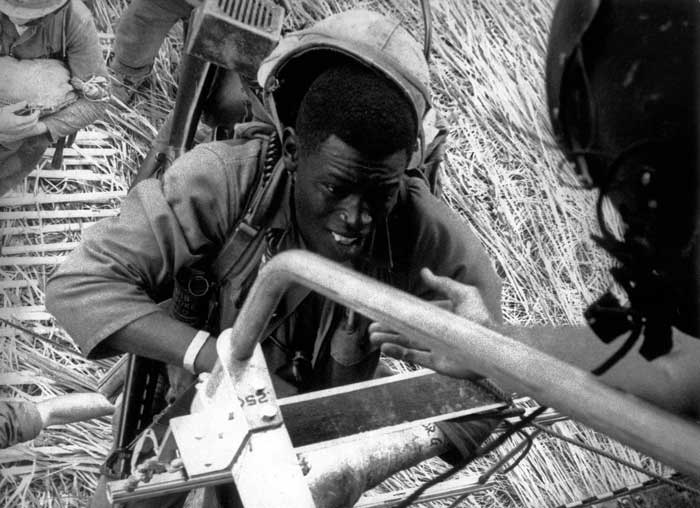
A wounded radio operator climbs into the rear of CH-47 Chinook for unit pickup. Photo by Marvin J. Wolf.
I felt, rather than heard, the concussion of a pair of rockets exploding on the ridge above us. The jungle rushed up. Branches clutched at our landing skids. Tree limbs and leaves flashed by. Behind me, the crew chief opened up with his M60, a stream of red tracers ricocheting off the ground. A stream of glowing green golf balls, lethal Viet Cong tracers, curved down from high on the ridge, tracking us as we fell into the LZ. Somehow, they all missed.
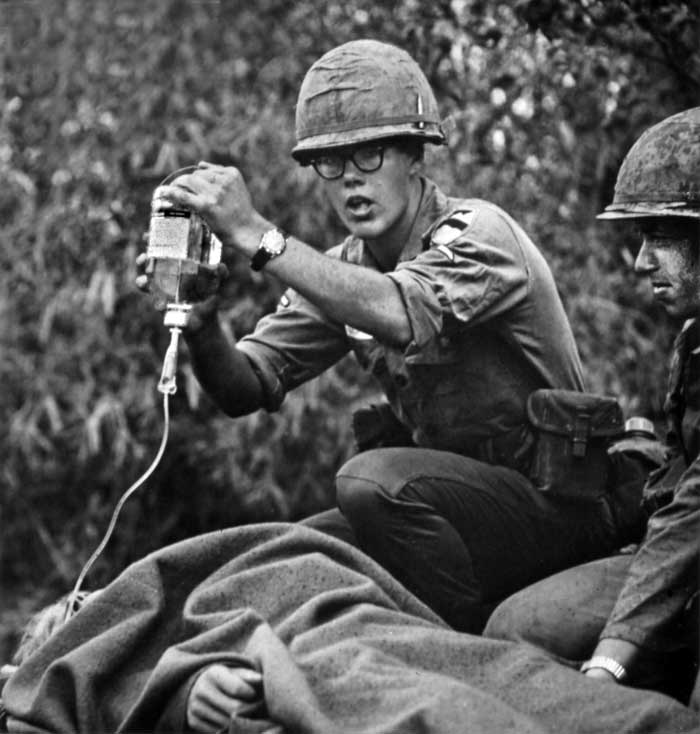
A medic delivers plasma to a wounded infantryman of the 1st Battalion, 12th Cavalry. Photo by Marvin J. Wolf.
Three feet short of the turf, the grunt next to me leaped out. I followed, stumbled, found my feet, hit the ground running, fighting for balance, feeling more ridiculous than vulnerable, clutching a rifle in my left hand and that ancient camera in my right. It was 40 yards, give or take, to the edge of the clearing, to the tree line and the illusion of cover. The camera bag hammered my hip with every step. I weighed 50 tons, running through quicksand. Steel-jacketed hornets buzzed past my ears; for once I was glad to be a five-foot soldier in a six-foot army. I threw myself behind a big tree, near a rifleman firing into the jungle.
Gasping for air, I heard the chopper rev up behind me and suddenly became conscious of a crackling crescendo of gunfire all around. I had landed awkwardly, and as I struggled to turn my body, the firing doubled and then redoubled. The empty Huey struggled skyward; a long, deep breath later and another one slipped down through the greenery. A hurricane of jungle-floor debris, driven by furious blades, stung every inch of my exposed skin.

A wounded infantryman from the 5th Battalion, 7th Cavalry is carried to a waiting medevac helicopter by members of his squad. Photo by Marvin J. Wolf.
I snaked my body around maybe 90 degrees and brought the Graphic up, cocked the shutter with my left hand, and aimed through the square of wire, the so-called sports finder. A GI sprinted toward me, went prone 10 feet away, and let loose a whole M16 magazine, fully automatic, into the jungle.
At God knows what.
I tried to take a picture. I had forgotten to cock the shutter. I cocked it and snapped it just as the second bird hovered out. The firing picked up again and I realized I had also forgotten to remove the dark slide protecting the film from accidental exposure. I had yet to make a picture! This was not the first time I had used a Graphic, nor the first that I had made such mistakes, but now something about my situation seemed hilarious. I laughed aloud.
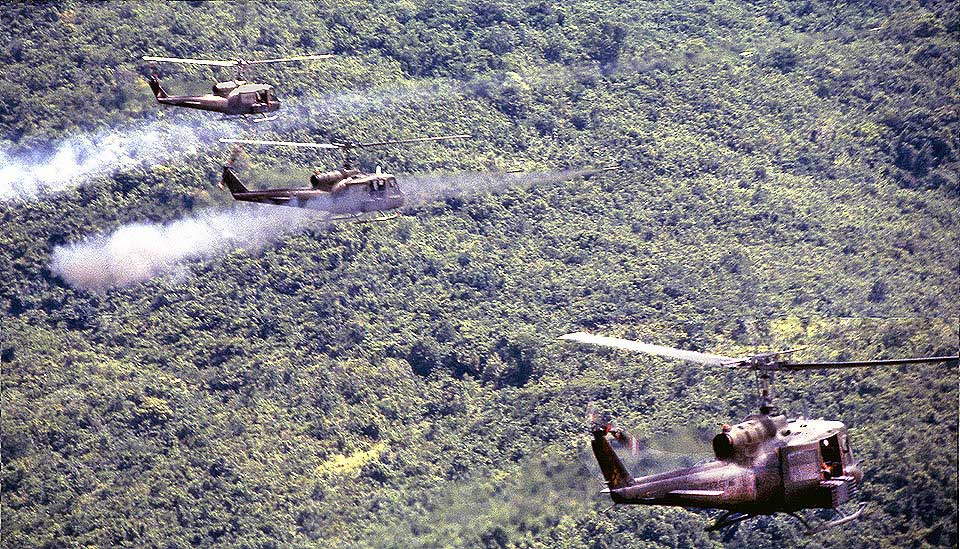
A battery of aerial rocket artillery bombards NVA emplaced above Bong Son in the Central Highlands. Photo by Marvin J. Wolf.
Then, a moment of near calm. The shooting tapered off to single shots. From higher on the hill came the unmistakable cough of a mortar firing. I went prone and counted the seconds until it exploded in the trees well short of the LZ.
The shadow of something big and incredibly fast whizzed overhead and I heard a salvo of rockets unleashed, then the banshee-like howl of an Air Force F-4 Phantom as it climbed up and away.
I shoved the dark slide into a pocket, cocked the shutter, and composed carefully as the third and last chopper touched down and men spilled out and ran past me. I snapped. It was such a perfect composition that I laughed again.
Our Journalism Depends on Your Support
The grunt on the ground nearby rolled over to reload, then looked around to stare at me, pain in his eyes. Then he laughed.
He pointed at my camera, and I dropped it from my face. The front end of the Graphic was bashed in. A ricochet, maybe, though I had felt nothing.
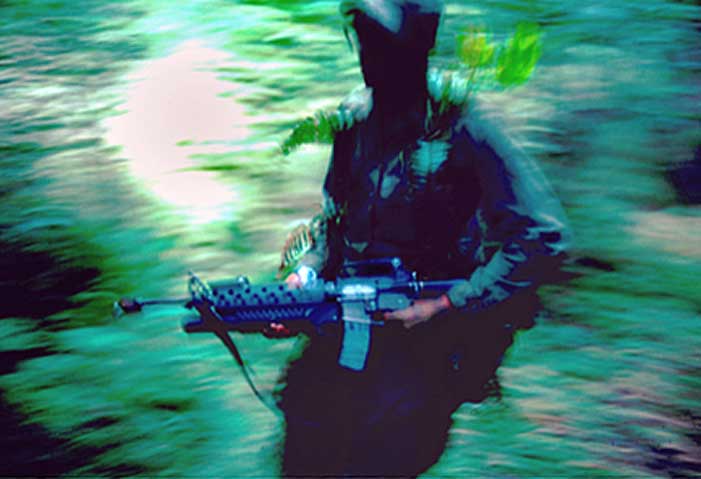
A 1st Cavalry trooper on recon patrol deep in the jungle of the Central Highlands. Photo by Marvin J. Wolf.
“Hey, PIO! This mean I don’t get my picture in Stars and Stripes?”
I dropped the useless Graphic and fumbled my personal 35 mm Leica III C from an ammo pouch on my belt. It was older than the Graphic—so old that before each exposure I had to wind the film with four turns of a knob. But it was a Leica, and it worked perfectly—my treasure. Using it was simple, second nature. I crawled forward and pulled myself up into a crouch. I braced myself against a tree. A noncom got up, started moving guys around, organizing a perimeter. I began taking photos, moving about to get different angles.
Gradually I realized that things would probably work out for me. This was now my job, and I knew I could do it.
This War Horse reflection was written by Marvin J. Wolf, edited by Kristin Davis, fact-checked by Jess Rohan, and copy-edited by Mitchell Hansen-Dewar. Abbie Bennett wrote the headlines.
All photos taken with a Nikon F with various lenses, from 28mm to 200mm. Black and white film was TRI-X; color was Kodachrome 25 to 64.





Comments are closed.